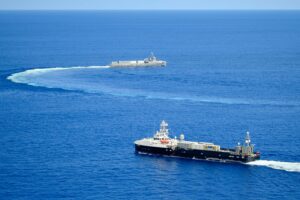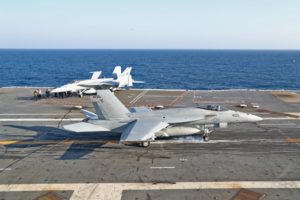The Fiscal Responsibility Act (FRA) budget caps imposed on the Department of the Navy forced it to lower funding for unmanned vessels and work on the next carrier-based fighter under Next Generation Air Dominance (NGAD).
According to briefing slides viewed by reporters on March 8 ahead of the president’s fiscal year 2025 budget (PB25) rollout, the Navy particularly made short term cuts to research and development funds affecting future systems.
“PB25 accepts future risks in future capabilities due to FRA caps,” the document said.

This means the Large Unmanned Surface Vessel (LUSV) program was lowered to $54 million for PB25 compared to $117 million in PB24 and the Orca Extra Large Unmanned Undersea Vehicle (XLUUV) is funded with $21 million after PB24 funded it at $104 million.
Rear Adm. Ben Reynolds, Deputy Assistant Secretary of the Navy for Budget, indicated LUSV was pushed back, in part, due to technical issues.
He told reporters during a March 8 press roundtable that while some smaller unmanned undersea vehicles (UUVs) are “doing very well” and transitioning from research and development to procurement, but some of the larger unmanned systems that may be experiencing technical difficulties are being “rephased” or pushed back across the five-year Future Years Defense Program (FYDP).
“So, LUSV, for example, we are moving that from ‘25 to ‘27. But, we’re seeing our unmanned systems of various sizes, in the air, surface ,and subsurface doing exceptionally,” he continued.
The Navy previously planned to start buying the LUSV with one in FY ‘25, two in FY ‘26 and three each in 2027 and 2028. This budget request now pushes the first LUSV to FY ‘27. The Navy plans to use LUSV as additional missile launchers as adjunct magazines to manned ships operating in the region.
The Navy’s FY ‘25 budget highlights book said it funds research and development on all USVs at $172.2 million and UUVs at $191.5 million.
Reynolds also confirmed XLUUV is also being pushed back later into the FYDP.
He said the Navy is investing about $1 billion in PB25 towards the DoD Replicator initiative, but the Navy did not provide a breakdown of programs or vehicles.

Under Secretary of the Navy Erik Raven emphasized despite the changes to some unmanned vessel schedules “we continue to see unmanned as the future of so many important naval capabilities, and we are making those investments in this budget.”
Similarly, the officials admitted most of the previously planned FY ‘25 funding for F/A-XX is being re-phased across the FYDP due to the budget caps.
F/A-XX is billed as the next generation aircraft carrier-based fighter that will be the manned component to the Navy’s Next Generation Air Dominance (NGAD) program. NGAD aims to include manned aircraft paired with unmanned vehicles.
Reynolds said while the service is “absolutely committed to the capacity and lethality of the carrier air wing,” the Navy did reduce planned F/A-XX funding by about $1 billion in FY ‘25 from $1.5 billion to $500 million.
Reynolds said this was “re-phased” across the FYDP, “but [we] have not abandoned that. What we’re doing is…two things: FRA drives hard choices. And so we are investing readiness in our ability to fight today, one; and two, we are rephasing as technology matures. So still committed to F/A-XX as we go forward.”
Raven added guidance prioritizes programs like the Columbia-class ballistic missile submarine and readiness over “touch choices to be made” on future modernization, given the FRA caps.
“So if you look at F/A-XX or other X programs, we knowingly took risk in the schedule for development of those programs in order to prioritize those key investments, whether that’s readiness or investing in our people or undersea, to make sure that we make those programs whole.”